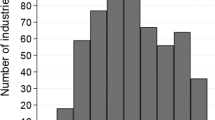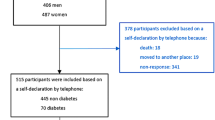Abstract
To date, most estimates of the half-life of polychlorinated biphenyls (PCBs) in humans have been based on relatively short follow-up periods. To address this issue, we determined the half-lives of PCB congeners of occupational origin in the serum of former capacitor workers as part of a study conducted in 2003–2006 — approximately 28 years after their last occupational exposure. A total of 241 persons from a source population of 6798 former capacitor workers were interviewed and asked to donate a blood sample for serum PCB congener analysis. A subgroup of 45 participants also had serum archived from 1976 and reanalyzed for the same 27 PCB congeners by the same laboratory. Our estimates of the half-lives of the congeners among these 45 persons were longer than those reported by Wolff et al. (1992), due primarily to the much longer interval between exposure and determination of serum PCB concentrations. Half-lives were significantly greater for the heavy versus light occupational congeners, for women versus men and for those with low versus high initial exposure. Current serum total PCB concentrations, expressed as the geometric mean of wet weight data, averaged 6.7 ng/g for the entire 241-person cohort, which represents a 10-fold decrease from values reported in the late 1970s, but is still nearly twice the average for persons of similar age residing in the same area, but without occupational exposure. In addition, current serum PCB concentrations remained significantly and positively associated with earlier occupational exposure, but were not associated with fresh water fish consumption. In general, the results support a consistent and long-duration trend of increased PCB body burden in this cohort of former capacitor workers compared with non-occupationally exposed individuals. The results may aid in further understanding the toxicological/epidemiological consequences of exposure to PCBs in humans.
This is a preview of subscription content, access via your institution
Access options
Subscribe to this journal
Receive 6 print issues and online access
$259.00 per year
only $43.17 per issue
Buy this article
- Purchase on Springer Link
- Instant access to full article PDF
Prices may be subject to local taxes which are calculated during checkout

Similar content being viewed by others
References
ATSDR. Toxicological Profile for Polychlorinated Biphenyls (PCBs), Department of Health and Human Services, Atlanta, GA, USA, 2000.
Brock J.W., Burse V.W., Ashley D.L., Najam A.R., Green V.E., and Korver M.P., et al. An improved analysis for chlorinated pesticides and polychlorinated biphenyls (PCBs) in human and bovine sera using solid-phase extraction. J Anal Toxicol 1996: 20: 528–536.
Centers for Disease Control and Prevention. Third National Report on Human Exposure to Environmental Chemicals. CDC, Atlanta, GA, USA, 2005.
Erickson M.D. Analytical Chemistry of PCBs. CRC Press, Boca Raton, FL, USA, 1997.
Falk C., Hanrahan L., Anderson H.A., Kanarek M.S., Draheim L., and Needham L., et al. Body burden levels of dioxin, furans, and PCBs among frequent consumers of Great Lakes sport fish. Environ Res 1999: 80: 519–525.
Friedman N.A. Calculus and Mathematical Models. Prindle, Weber and Schmidt, Boston, USA, 1979.
Fischbein A., Wolff M.S., Lilis R., Thornton J., and Selikoff I.J. Clinical findings among PCB-exposed capacitor manufacturing workers. Ann NY Acad Sci 1979: 320: 703–715.
Fitzgerald E.F., Belanger E.E., Gomez M.I., Cayo M., McCaffrey R., and Seegal R., et al. Polychlorinated biphenyl (PCB) exposure and neurophyschological status among older residents of upper Hudson River communities. Environ Health Perspect 2008: 116: 209–215.
Fitzgerald E.F., Belanger E.E., Gomez M.I., Hwang S.-A., Jansing R.L., and Hicks H.E. Environmental exposures to polychlorinated biphenyls (PCBs) among older residents of upper Hudson River communities. Environ Res 2007a: 104: 352–360.
Fitzgerald E.F., Hwang S.A., Gomez M., Bush B., Yang B.Z., and Tarbell A. Environmental and occupational exposures and serum PCB concentrations and patterns among Mohawk men at Akwesasne. J Expos Sci Environ Epidemiol 2007b: 17: 269–278.
Gammon M.D., Wolff M.S., Neugut A.I., Eng S.M., Teitelbaum S.L., and Britton J.A., et al. Environmental toxins and breast cancer on Long Island. II. Organochlorine compound levels in blood. Cancer Epidemiol Biomarkers Prev 2002: 11: 686–697.
Gray K.A., Klebanoff M.A., Brock J.W., Zhou H., Darden R., and Needham L., et al. In utero exposure to background levels of polychlorinated biphenyls and cognitive functioning among school-age children. Am J Epidemiol 2005: 162: 17–26.
Hanrahan L.P., Falk C., Anderson H.A., Draheim L., Kanarek M.S., and Olson J., et al. Serum PCB and DDE levels of frequent Great Lakes sport fish consumers—a first look. Environ Res Sec A 1999: 80: S26–S37.
Jacobson J.L., and Jacobson S.W. Prenatal exposure to polychlorinated biphenyls and attention at school age. J Pediatr 2003: 143: 780–788.
Kutz F.W., and Yang H.S.C. A Note on Polychlorinated Biphenyls in Air. Proceedings of the National Conference on Polychlorinated Biphenyls; 182. Environmental Protection Agency, Washington, DC, USA, 1975.
Lawton R.W., Ross M.R., Feingold J., and Brown J.F. Jr Effects of PCB exposure on biochemical and hematological findings in capacitor workers. Environ Health Perspect 1985: 60: 165–184.
Moysich K.B., Ambrosone C.B., Mendola P., Kostyniak P.J., Greizerstein H.B., and Vena J.E., et al. Exposures associated with serum organochlorine levels among postmenopausal women from western New York State. Am J Ind Med 2002: 41: 102–110.
National Research Council. Polychlorinated Biphenyls. National Academy of Sciences, Washington, DC, USA, 1979.
Phillips D.L., Pirkle J.L., Burse V.W., Bernert J.T. Jr, Henderson L.O., and Needham L.L. Chlorinated hydrocarbon levels in human serum: effects of fasting and feeding. Arch Environ Contam Toxicol 1989a: 18: 495–500.
Phillips D.L., Smith A.B., Burse V.W., Steele G.K., Needham L.L., and Hannon W.H. Half-life of polycholorinated biphenyls in occupationally exposed workers. Arch Environ Health 1989b: 44: 351–354.
Rylander L., Dyremark E., Strömberg U., Östman C., and Hagmar L. The impact of age, lactation and dietary habits on PCB in plasma in Swedish women. Sci Total Environ 1997: 207: 55–61.
Schantz S.L., Gasior D.M., Polverejan E., McCaffrey R.J., Sweeney A.M., and Humphrey H.E.B., et al. Impairments of memory and learning in older adults exposed to polychlorinated biphenyls via consumption of Great Lakes fish. Environ Health Perspect 2001: 109: 605–611.
Schantz S.L., Sweeny A.M., Gardiner J.C., Humphrey H.E., McCaffrey R.J., and Gasior D.M., et al. Neuropsychological assessment of an aging population of Great Lakes fisheaters. Toxicol Ind Health 1996: 12: 403–417.
Shirai J.H., and Kissel J.C. Uncertainty in estimated half-lives of PCBs in humans: impact on exposure assessment. Sci Total Environ 1996: 187: 199–210.
Stewart P., Reihman J., Gump B., Lonky E., Darvill T., and Pagano J. Response inhibition at 8 and 9 1/2 years of age in children prenatally exposed to PCBs. Neurotoxicol Teratol 2005: 27: 771–780.
Taylor P.R., and Lawrence C.E. Polychlorinated biphenyls: estimated serum half lives. Brit J Ind Med 1992: 49: 527–528.
Taylor P.R., Reilly A.A., Stelma J.M., and Lawrence C.E. Estimating serum polychlorinated biphenyl levels in highly exposed workers: an empirical model. J Toxicol Environ Health 1991: 34: 413–422.
Wolff M.S., Anderson H.A., Britton J.A., and Rothman N. Pharmacokinetic variability and modern epidemiology—The example of dichlorodiphenyltrichloroethane, body mass index, and birth cohort. Cancer Epidemiol Biomarkers Prev 2007: 16: 1925–1930.
Wolff M.S., Britton J.A., Boguski L., Hochman S., Maloney N., and Serra N., et al. Environmental exposures and puberty in inner-city girls. Environ Res 2008: 107: 393–400.
Wolff M.S., Britton J.A., Teitelbaum S.L., Eng S., Deych E., and Ireland K., et al. Improving organochlorine biomarker models for cancer research. Cancer Epidemiol Biomarkers Prev 2005: 14: 2224–2236.
Wolff M.S., Fischbein A., and Selikoff I.J. Changes in PCB serum concentrations among capacitor manufacturing workers. Environ Res 1992: 59: 202–216.
Wolff M.S., Fischbein A., Thornton J., Rice C., Lilis R., and Selikoff I.J. Body burden of polychlorinated biphenyls among persons employed in capacitor manufacturing. Int Arch Environ Health 1982: 49: 199–208.
Wolff M.S., Zeleniuch-Jacquotte A., Dubin N., and Toniolo P. Risk of breast cancer and organochlorine exposure. Cancer Epidemiol Biomarkers Prev 2000: 9: 271–277.
Yakushiji T., Watanabe I., Kuwabara K., Tanaka R., Kashimoto T., and Kunita N., et al. Rate of decrease and half-life of polychlorinated biphenyls in the blood of mothers and their children occupationally exposed to PCBs. Arch Environ Contam Toxicol 1984: 13: 341–345.
Acknowledgements
We profusely thank Ed Bloch for his assistance, and we express our appreciation to the United Electrical, Radio and Machine Workers of America Union Local 332 Executive Committee and the employees of the Fort Edward and Hudson Falls General Electric plants for their participation. In addition, we thank the NYSDOH staff who contributed to this study including Karl Brosch, Lenore Gensberg, Susan Heckman, and Gwen Mergian. We acknowledge the technical support of Karen Ireland and Zhisong Lui at Mount Sinai School of Medicine for the laboratory analyses. We are grateful for the input and valuable advice of Dr. Susan Korrick of the Department of Environmental Health, Channing Laboratory, Harvard School of Public Health on the design of this study. This study was supported in part by the United States Army Grant Number DAMD17-02-1-0173 to Richard F. Seegal.
Author information
Authors and Affiliations
Corresponding author
Ethics declarations
Competing interests
The authors declare no conflict of interest.
Rights and permissions
About this article
Cite this article
Seegal, R., Fitzgerald, E., Hills, E. et al. Estimating the half-lives of PCB congeners in former capacitor workers measured over a 28-year interval. J Expo Sci Environ Epidemiol 21, 234–246 (2011). https://doi.org/10.1038/jes.2010.3
Received:
Accepted:
Published:
Issue Date:
DOI: https://doi.org/10.1038/jes.2010.3
Keywords
This article is cited by
-
Ten years after: findings from the medical surveillance program on Health Effects in High-Level Exposure to PCB (HELPcB)
Archives of Toxicology (2023)
-
Human health risk surveillance of polychlorinated biphenyls in bovine milk from alluvial plain of Punjab, Pakistan
Environmental Science and Pollution Research (2022)
-
Maternal exposure to airborne polychlorinated biphenyls (PCBs) and risk of adverse birth outcomes
European Journal of Epidemiology (2021)
-
Use of plasma exchange or double filtration plasmapheresis to reduce body burden of polychlorinated biphenyls: A pilot trial
Journal of Exposure Science & Environmental Epidemiology (2017)
-
Temporal trends of lipophilic persistent organic pollutants in serum from Danish nulliparous pregnant women 2011–2013
Environmental Science and Pollution Research (2017)



